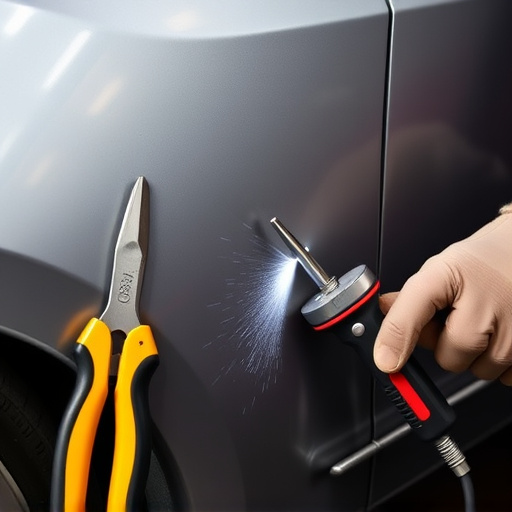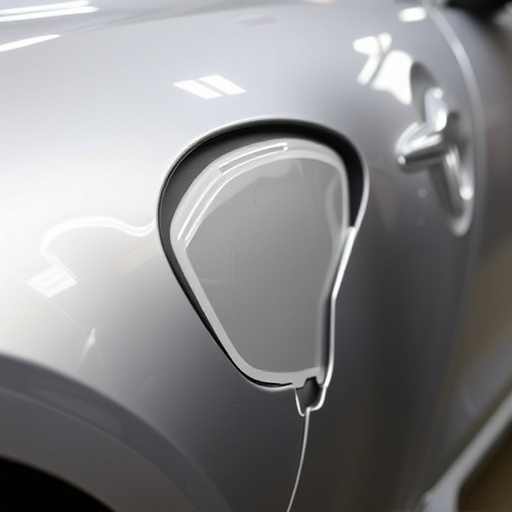Changing wheels on your Mercedes requires resetting the Tire Pressure Monitoring System (TPMS) for optimal performance and safety. This involves turning on the ignition, accessing the control module, initiating a reset, inflating tires to specified PSI from the owner's manual, and taking a test drive. Regular auto repairs are crucial for maintaining accurate TPMS readings. Challenges may arise due to sensor communication issues, necessitating model-specific instructions from the owner's manual, ensuring tire pressure recommendations are met, using reliable TPMS re-activation tools, charging the battery, and seeking professional help if needed, especially post-repair work.
Changing wheel or rim sizes on your Mercedes can disrupt the tire pressure monitoring system (TPMS). Learn how to easily reset the TPMS to ensure optimal vehicle performance and safety. This guide covers everything you need to know, from understanding the Mercedes TPMS and its functionality to step-by-step instructions for a successful reset. Discover common issues and tips to make the process seamless.
- Understanding Mercedes TPMS and Its Functionality
- Steps to Reset Tire Pressure Monitor After Size Change
- Common Issues and Tips for Successful Reset
Understanding Mercedes TPMS and Its Functionality

The Mercedes Tire Pressure Monitoring System (TPMS) is a sophisticated technology designed to ensure optimal vehicle safety and performance. It constantly monitors tire pressure and alerts drivers when there’s a significant discrepancy, helping to prevent underinflation, which can compromise handling, fuel efficiency, and tire longevity. This system plays a crucial role in maintaining the overall health of a Mercedes’ suspension and reducing the risk of accidents caused by tire failure.
When you change a wheel or rim size on a Mercedes vehicle, it’s essential to reset the TPMS accurately. This process ensures that the system recognizes the new tire specifications and provides precise pressure readings for each tire. Failing to perform this reset can lead to incorrect pressure monitoring, potentially causing unnecessary worry for drivers and even affecting fuel economy. Therefore, understanding how to properly reset the Mercedes TPMS after wheel or rim modifications is vital for any car owner.
Steps to Reset Tire Pressure Monitor After Size Change

After changing a wheel or rim size on your Mercedes, resetting the tire pressure monitor (TPMS) is an essential step to ensure optimal vehicle performance and safety. Here’s how you can do it:
1. Turn on Your Ignition: Start by turning on your Mercedes’ ignition, but keep the engine off. This initial step activates the TPMS system.
2. Access the Control Module: Locate your vehicle’s control module, often found under the steering wheel or in the glove compartment. Some models might have it in the trunk as well.
3. Reset Using the Control Module: Use the control module to initiate a reset by following the on-screen instructions or using the provided tools. This process may vary slightly depending on your Mercedes model, so refer to your vehicle’s manual for specific guidance.
4. Inflate Tires to Specified Pressure: Once the reset is complete, ensure each tire is inflated to the recommended pressure indicated in your owner’s manual. Proper tire inflation is crucial not just for TPMS functionality but also for overall auto maintenance and safety during driving.
5. Test Drive Your Mercedes: After resetting the TPMS and inflating the tires, take a short test drive to allow the system to recalibrate and confirm that everything is functioning correctly. Regular auto repair services and proper car body repair can contribute to maintaining your TPMS and ensuring it remains accurate.
Common Issues and Tips for Successful Reset

When resetting your Mercedes TPMS (Tire Pressure Monitoring System) after changing a wheel or rim size, common issues can arise that can make the process seem daunting. One frequent problem is miscommunication between the sensors and the system’s central unit, often due to variations in tire diameter or pressure set points. This can result in error codes or persistent alerts even after adjusting the pressure.
To ensure a successful Mercedes tire pressure monitor reset, follow these tips: always refer to your vehicle’s owner manual for specific instructions tailored to your model. Double-check that all tires, including the spare, meet the manufacturer’s recommended PSI. Utilize a reliable TPMS re-activation tool or scanner, and make sure the battery is charged before attempting the reset. Additionally, consider professional assistance from trusted auto frame repair or vehicle repair services if you’re uncertain or facing persistent issues, especially when dealing with paintless dent repair to ensure no underlying structural changes compromise the system’s integrity.
After changing your Mercedes’ wheel or rim size, resetting the tire pressure monitor (TPMS) is essential for optimal vehicle performance and safety. Following the detailed steps outlined in this article, you can successfully perform a TPMS reset. Remember to address common issues and tips for a seamless process, ensuring your Mercedes’ TPMS functions correctly and efficiently. For a hassle-free experience, always refer to your vehicle’s owner manual when dealing with sensitive systems like TPMS.














